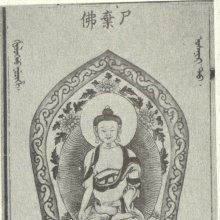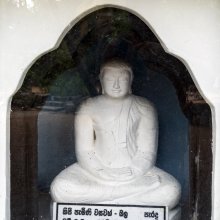Sikhin, Shikhin, Śikhin: 24 definitions
Introduction:
Sikhin means something in Buddhism, Pali, Hinduism, Sanskrit, Jainism, Prakrit, the history of ancient India, biology. If you want to know the exact meaning, history, etymology or English translation of this term then check out the descriptions on this page. Add your comment or reference to a book if you want to contribute to this summary article.
Sikhin has 23 English definitions available.
The Sanskrit term Śikhin can be transliterated into English as Sikhin or Shikhin, using the IAST transliteration scheme (?).
Images (photo gallery)
Languages of India and abroad
Sanskrit dictionary
[Deutsch Wörterbuch]
Source: Cologne Digital Sanskrit Dictionaries: Böhtlingk and Roth Grosses Petersburger WörterbuchŚikhin (शिखिन्):—(von śikhā)
1) adj. gaṇa vrīhyādi zu [Pāṇini’s acht Bücher 5, 2, 116.] balādi zu [136.] [Vopadeva’s Grammatik 7, 30.] a) einen Haarbusch tragend [Trikāṇḍaśeṣa 3, 3, 264.] [Hemacandra’s Anekārthasaṃgraha 2, 287. fg.] [Medinīkoṣa Nalopākhyāna 142.] [GṚHYAS. 2, 52.] jaṭī śikhī muṇḍī [Sânkhya Philosophy 19.] [Atharvavedasaṃhitā 19, 22, 15.] [Mahābhārata 4, 1639. 7, 9504. 13, 1171. 2277. 3694.] [Harivaṃśa 10594. 11866.] [Rāmāyaṇa 3, 52, 9.] [Oxforder Handschriften 148], a, [No. 318. 268], b, [?20. GAUḌAP. zu SĀṂKHYAK. 22.] — b) auf der Höhe der Wissenschaft stehend: agneriva śikhā cānyā yasya jñānamayī śikhā . sa śikhītyucyate vidvān [BRAHMOPANIṢAD] in [Weber’s Indische Studien 1, 383, Nalopākhyāna 1.] m. ein Brahman [ŚABDĀRTHAK.] bei [WILSON.] —
2) m. a) Pfau [Amarakoṣa 2, 5, 30. 3, 4, 18, 109.] [Hemacandra’s Abhidhānacintāmaṇi 14. 1319.] [Hemacandra’s Anekārthasaṃgraha] [Medinīkoṣa] [Halāyudha 2, 86.] [Prātiśākhya zum Ṛgveda 13, 20.] [Yājñavalkya’s Gesetzbuch 3, 324.] [Mahābhārata 3, 2858. 4, 191. 6, 71.] [Rāmāyaṇa 2, 56, 9.] [Suśruta 1, 107, 8.] [Vikramorvaśī 41.] [Śiśupālavadha 4, 50.] [Spr. (II) 164. 2575. 5051. (I) 2832.] [Varāhamihira’s Bṛhajjātaka S. 3, 28. 24, 19. 34, 4. 48, 6. 68, 115.] [Kathāsaritsāgara 14, 18.] [Rājataraṅgiṇī 3, 335.] śikhipuccha [Śabdaratnāvalī im Śabdakalpadruma] — b) Hahn [Trikāṇḍaśeṣa] [Hemacandra’s Anekārthasaṃgraha] [Medinīkoṣa] — c) Ardea nivea [Trikāṇḍaśeṣa 2, 5, 24.] — d) Stier [Hemacandra’s Anekārthasaṃgraha] [Medinīkoṣa] — e) Pferd [Hemacandra’s Anekārthasaṃgraha] — f) Feuer, der Gott des Feuers [Amarakoṣa 3, 4, 18, 109.] [Hemacandra’s Abhidhānacintāmaṇi 1099.] [Hemacandra’s Anekārthasaṃgraha] [Medinīkoṣa] [Hārāvalī 162.] [Halāyudha 1, 62.] [GṚHYAS. 1, 6.] [Yājñavalkya’s Gesetzbuch 3, 127.] [Mahābhārata 1, 932. 2, 434. 1147. 3, 547. 4, 1710. 5, 1308. 12, 8556.] [Rāmāyaṇa 2, 98, 8. 3, 55, 11. 6, 86, 34.] [Mṛcchakaṭikā 85, 8.] [Raghuvaṃśa 19, 54.] [Śiśupālavadha 15, 7.] [Varāhamihira’s Bṛhajjātaka S. 5, 60. 9, 44. 11, 11. 43, 65. 53, 43. 51. 119.] [BṚH. 2, 6.] kṣatrasya śastraśikhinaḥ śamamadya yāntu [UTTARAR. 110, 19 (149, 14).] [Spr. (II) 355. 2488. 4812. (I) 2486.] [Gītagovinda 7, 40.] aurva [Oxforder Handschriften 129,a,11.] [PAÑCAR.3,7,19.] — g) Bez. der Zahl drei (wegen der drei heiligen Feuer) [Varāhamihira’s Bṛhajjātaka S. 77, 33. 98, 1.] [BṚH. 1, 13.] [LAGHUJ. 1, 21] in [Weber’s Indische Studien 2, 282.] — h) Lampe [Śabdakalpadruma] und [WILSON.] — i) Bez. verschiedener Pflanzen: Carpopogon pruriens [Ratnamālā im Śabdakalpadruma] Trigonella foenum graecum und = sitāvara [Rājanirghaṇṭa im Śabdakalpadruma] — k) Komet [Hemacandra’s Abhidhānacintāmaṇi 122.] [Hemacandra’s Anekārthasaṃgraha] [Medinīkoṣa] [Halāyudha 1, 49.] [Varāhamihira’s Bṛhajjātaka S. 3, 11. 11, 4. 14, 27. 12, 5. 21. 47, 12. 14] [?(Spr. 2649). fg.] vielleicht der niedersteigende Knoten [20, 6.] [BṚH. 2, 3.] [YOGAYĀTRĀ 1, 12. 3, 20]; vgl. [Weber’s Indische Studien 10, 199. 210. fg.] śikhicāra Kometenlauf als Titel eines Buches oder Abschnittes [Varāhamihira’s Bṛhajjātaka 11, 1.] — l) Berg [ŚABDĀRTHAK.] bei [WILSON.] — m) Pfeil [Hemacandra’s Anekārthasaṃgraha] [Medinīkoṣa] — n) Baum diess. — o) Nomen proprium α) eines Schlangendämons [Mahābhārata 5, 3628.] — β) des Indra unter Manu Tāmasa [Viṣṇupurāṇa 3, 1, 17.] śikhi [Mārkāṇḍeyapurāṇa] śibi [WILSON,] [Viṣṇupurāṇa] — γ) des 2ten Buddha [Hemacandra’s Abhidhānacintāmaṇi 236.] [Rgva tch’er rol pa ed. Calc. 5, 22.] [WILSON, Sel. Works 1, 290. 2, 5. 8. 13.] [BURNOUF,] [Intr. 222. 317] (śikin gedr.). [533.] [Lot. de Lassen’s Anthologie b. l. 503.] — δ) eines Brahman (der Gott) [Lot. de Lassen’s Anthologie b. l. 3. 106.] —
3) f. śikhinī a) Pfauhenne [Rāmāyaṇa 3, 79, 14.] — b) eine best. Staude, = mayūraśikhā [Rājanirghaṇṭa im Śabdakalpadruma] — Vgl. ratna, śaracchikhin, śaikhina .
Sanskrit, also spelled संस्कृतम् (saṃskṛtam), is an ancient language of India commonly seen as the grandmother of the Indo-European language family (even English!). Closely allied with Prakrit and Pali, Sanskrit is more exhaustive in both grammar and terms and has the most extensive collection of literature in the world, greatly surpassing its sister-languages Greek and Latin.
See also (Relevant definitions)
Starts with (+8): Shikhibhaya, Shikhibhu, Shikhidhvaja, Shikhidish, Shikhigala, Shikhigriva, Shikhikana, Shikhikantha, Shikhimoda, Shikhimrityu, Shikhina, Shikhinandita, Shikhinayana, Shikhindhana, Shikhindi, Shikhindra, Shikhinetra, Shikhini, Shikhipatra, Shikhipiccha.
Ends with: Avabhasanashikhin, Indrayudhashikhin, Mahabrahmashikhin, Pancashikhin, Ratnashikhin, Rohashikhin, Shastrashikhin, Tagarashikhin, Tamrashikhin, Tilashikhin, Trishikhin, Vishikhin.
Full-text (+45): Tamrashikhin, Shaikhina, Shikhidish, Shikhi, Shastrashikhin, Shikhishikha, Shikhikantha, Shikhigriva, Shikhidhvaja, Pancashikhin, Shikhishekhara, Shikhita, Indrayudhashikhin, Rohashikhin, Ratnashikhin, Tagarashikhin, Tilashikhin, Shikhikana, Shikhiyupa, Dhumasikha.
Relevant text
Search found 24 books and stories containing Sikhin, Shikhin, Śikhin; (plurals include: Sikhins, Shikhins, Śikhins). You can also click to the full overview containing English textual excerpts. Below are direct links for the most relevant articles:
Vimalakirti Nirdesa Sutra (by Robert A. F. Thurman)
Maha Prajnaparamita Sastra (by Gelongma Karma Migme Chödrön)
I. Apparent longevity of the buddhas < [Part 16 - Obtaining the immense longevity and immense radiance of the Buddhas]
Appendix 7 - The Buddha’s assistants (upasthāyaka) < [Chapter XLI - The Eighteen Special Attributes of the Buddha]
Twelve-membered speech of the Buddha: Final comments < [Part 2 - Hearing the twelve-membered speech of the Buddha]
The Skanda Purana (by G. V. Tagare)
Chapter 202 - The Greatness of Śikhitīrtha (śikhi-tīrtha) < [Section 3 - Revā-khaṇḍa]
Chapter 14 - Manifestation of Śaṅkara < [Section 3b - Arunācala-khaṇḍa (Uttarārdha)]
Chapter 90 - Greatness of Vasordhārā < [Section 1 - Tīrtha-māhātmya]
The Mahavastu (great story) (by J. J. Jones)
Chapter XXI - Former Buddhas < [Volume III]
Chapter X - The Buddha’s Visit to Kapilavastu < [Volume III]
Trishashti Shalaka Purusha Caritra (by Helen M. Johnson)
Part 8: Story of Brāhman boy < [Chapter I - Five previous incarnations]
Part 4: Incarnation as Marīci < [Chapter I - Previous births of Mahāvīra]
Bodhisattvacharyavatara (by Andreas Kretschmar)
Text Section 44 < [Khenpo Chöga’s Oral Explanations]
Related products

